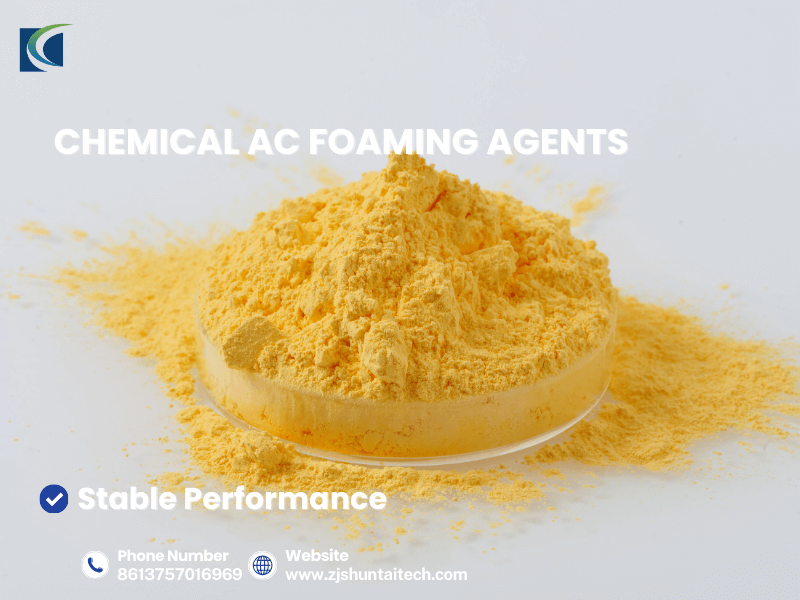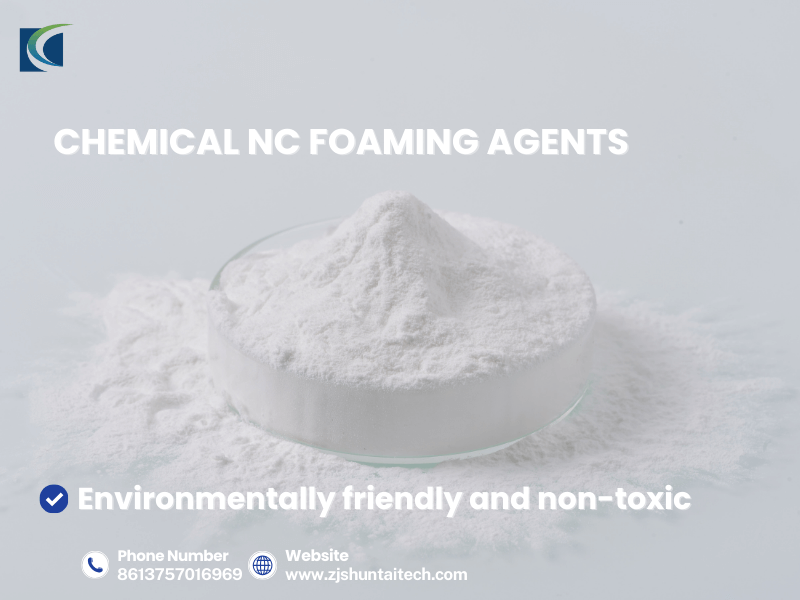Foaming Agents: the core support for foam plastics production
Foaming agents, as chemical substances that generate gas during plastic processing to form a honeycomb structure within the material, are the core enablers of foam plastics' unique properties. In foam plastic production, they fulfill multiple critical functions: reducing material density to create lighter products; enhancing thermal insulation to meet energy-saving demands in construction and appliances; improving cushioning and shock absorption for protective packaging in electronics and food transport; and optimizing material efficiency to reduce raw material consumption and lower production costs.
Growing Demand for AC and NC Foaming Agents in Foam Plastics
In recent years, rapid development in packaging, construction, and automotive industries has driven sustained growth in foam plastic demand, directly boosting requirements for AC (azodicarbonamide) and NC (nitrosourea) blowing agents. Industry data for 2024 illustrates this trend: the packaging sector saw a 15% year-on-year increase in demand for cushioning foam due to booming e-commerce; The construction sector, driven by green building concepts, saw a 12% annual growth rate in demand for insulation foam plastics; The automotive industry, pursuing lightweighting, continues to increase its use of foam plastic components. With their respective outstanding properties, AC and NC foaming agents have become the preferred choice for foam plastic production in these fields.

The chemical name for AC foaming agents is azobis(2-methylpropionamide), with the molecular formula C₂H₄N₄O₂. During foam plastic processing, when temperatures reach 160-200°C, AC foaming agents undergo thermal decomposition. During this process, it primarily releases gases such as nitrogen (N₂), carbon monoxide (CO), and carbon dioxide (CO₂). These gases form bubbles within the plastic melt, ultimately creating a porous foam structure.
Core Properties of AC Foaming Agent for Foam Plastics
AC blowing agent possesses several core properties advantageous for foam plastic production. First, it exhibits an exceptionally high gas yield of 190-220 mL/g. This means that only a small amount of AC blowing agent is required during production to generate a large volume of gas, maximizing foam cell density and reducing production costs. Second, AC foaming agents exhibit low toxicity and excellent compatibility with common thermoplastics such as polyethylene (PE), polypropylene (PP), polyvinyl chloride (PVC), and polystyrene (PS), broadening their application scope. Additionally, AC foaming agents maintain excellent stability during storage and processing, preventing premature gas release and ensuring smooth foam plastic production.

NC foaming agents, also known as nitrosourea compounds, include common types such as N,N'-dinitrosopentamethylenetetramine (DNPT). Unlike AC foaming agents, NC foaming agents exhibit a lower thermal decomposition temperature, typically ranging from 100-140°C. This characteristic makes them highly suitable for heat-sensitive plastic materials, preventing high-temperature degradation of plastic properties during processing.
Advantages of NC blowing agents over alternatives
In foam plastic production, NC blowing agents offer distinct advantages over other alternatives. First, they form fine and uniform cell structures, which is crucial for producing microcellular foams. For products demanding extremely precise foam structures—such as automotive interior components and medical devices—using NC blowing agents significantly enhances product quality. Second, NC blowing agents effectively reduce foam shrinkage, improving dimensional stability in thin-walled foam products and ensuring compliance with design specifications.
Limitations of NC Foaming Agents: Safety and Processing Considerations
Despite their excellent performance, NC blowing agents also present certain limitations. Regarding safety, NC foaming agents may generate nitrosamines during use, which pose potential health risks. Therefore, strict adherence to relevant regulations—such as the nitrosamine content limits set by the U.S. Food and Drug Administration (FDA) and the European Union's Registration, Evaluation, Authorization, and Restriction of Chemicals (REACH) regulation—is essential during production. Processing-wise, NC blowing agents have a narrow processing window. During high-speed production, uneven gas distribution can occur, affecting the quality stability of the foam plastic.
Comparison Analysis of AC and NC Blowing Agents
Performance Metrics: Gas Yield, Cell Structure, and Material Compatibility
| Performance Metrics |
AC Foaming Agent |
NC blowing agent |
| Decomposition Temperature |
160-200°C |
100-140°C |
| Gas Yield |
190-220 mL/g |
120–150 mL/g |
| Cell uniformity |
Good (suitable for standard foam) |
Excellent (suitable for microcellular foam) |
| Material Compatibility |
PE, PP, PVC, PS |
PVC, Polyurethane (PU), Acrylonitrile-Butadiene-Styrene Copolymer (ABS, heat-sensitive type) |
Cost-Effectiveness: Total Cost of Ownership for Mass Production
From a cost-effectiveness perspective, AC blowing agents offer significant advantages in mass production. Their lower unit cost combined with high gas yield effectively reduces material usage, thereby lowering overall material expenses. While NC blowing agents have a higher unit cost, they reduce scrap rates in precision foam products (e.g., electronic packaging), helping control production costs over the long term.
Applications of AC and NC Blowing Agents in the Foam Plastics Industry
AC blowing agents: Primary applications in high-volume foam products
Leveraging its high gas yield and excellent compatibility, AC blowing agent is widely used in high-volume foam production. In packaging, it is employed to manufacture expanded polystyrene (EPS) for cushioning protection in electronics and food transportation. In construction, AC blowing agents are used to manufacture extruded polystyrene (XPS) insulation boards, which offer excellent thermal insulation properties and effectively reduce building energy consumption; In the automotive sector, AC blowing agents are employed in the production of polypropylene (PP) foam for components like automotive bumper cores and door trim panels, contributing to vehicle weight reduction.
NC Foaming Agent: Specialized Applications in Precision Foams
NC blowing agents play a crucial role in precision foam production due to their ability to form fine, uniform cell structures. In the medical field, they are used to produce polyvinyl chloride (PVC) microcellular foam for products like surgical gaskets. This foam not only exhibits excellent biocompatibility but also meets the high precision requirements of medical products. In electronics, NC blowing agents create ABS foam for device casings, providing shock absorption while ensuring dimensional stability. In textiles, they produce polyurethane (PU) foam for breathable insoles, enhancing wear comfort.
Practical Processing Methods for AC and NC Foaming Agents in Foam Plastics
Pre-treatment: Storage and Handling to Maintain Foaming Agent Efficacy
To ensure AC and NC blowing agents perform optimally during processing, proper storage and handling during the pretreatment phase are critical. AC blowing agents should be stored in cool, dry environments with moisture content below 5% to prevent caking and maintain performance. Due to their high reactivity, NC blowing agents must be stored away from oxidizing agents to reduce fire risks. It is recommended to use them within six months of purchase to avoid performance degradation from prolonged storage.
Forming/Extrusion Parameters: Optimizing Temperature and Pressure
Properly setting temperature and pressure parameters during molding and extrusion significantly impacts foam quality. For AC blowing agents, barrel temperature should be maintained 10-15°C below their decomposition temperature to prevent premature gas release and ensure uniform bubble distribution within the plastic melt. For NC foaming agents, which have lower decomposition temperatures, low-shear screws should be used during processing to prevent excessive shear-induced temperature increases that could impair uniform cell formation.
Post-Processing: Curing and Quality Control Ensure Foam Performance
Curing and quality control during post-processing are critical for ensuring foam plastic performance. Foam plastics produced with AC blowing agents require post-curing at 60-80°C to remove residual carbon monoxide and enhance product safety. For foams made with NC blowing agents, cell size distribution must be tested. Laser diffraction analysis can precisely measure cell dimensions in microcellular foams, ensuring product quality compliance.
Common Issues and Solutions for AC and NC Blowing Agents in Foam Production
Common AC Foaming Agent Issues: Causes and Solutions
When producing foam plastics with AC blowing agents, several common issues may arise. Issue 1: Large and uneven cells appear. This is typically caused by excessively high decomposition temperatures or insufficient cell stabilizer addition. Solutions include lowering the decomposition temperature by 5-10°C or appropriately adding cell stabilizers like zinc stearate to improve cell structure. Issue 2: Residual odor in foam plastic. This primarily results from insufficient post-curing time or incomplete removal of residual gases. Extend the post-curing duration or incorporate odor neutralizers to resolve this issue.
Common NC Foaming Agent Issues: Diagnosis and Defect Repair
Defects may also occur during production using NC foaming agents. Issue 1: Foam exhibits shrinkage. This may result from excessive cooling rates or insufficient NC foaming agent dosage. Solutions include reducing cooling rates or appropriately increasing NC foaming agent dosage, typically by 0.5-1% (by weight). Issue 2: Nitrosamines detected. This requires switching to a stabilized NC blowing agent formulation, such as one containing urea-based scavengers, to comply with relevant regulations.
Selecting the Appropriate Blowing Foaming Agent for Foam Plastic Requirements
In summary, both AC and NC blowing agents offer distinct advantages. The appropriate blowing agent should be selected for foam production based on specific requirements. AC blowing agents are suitable for cost-effective, high-volume foam production, such as packaging and building insulation foams. NC blowing agents are better suited for precision, heat-sensitive foam applications, such as medical devices and electronic packaging foams. In actual production, it is recommended to conduct small-scale pilot tests first to verify that the blowing agent's performance meets production requirements before proceeding to large-scale production.
Should you have any questions regarding the selection or application of AC and NC blowing agents, or require customized blowing agent recommendations, please contact our foam experts. We are committed to providing professional service and support.

